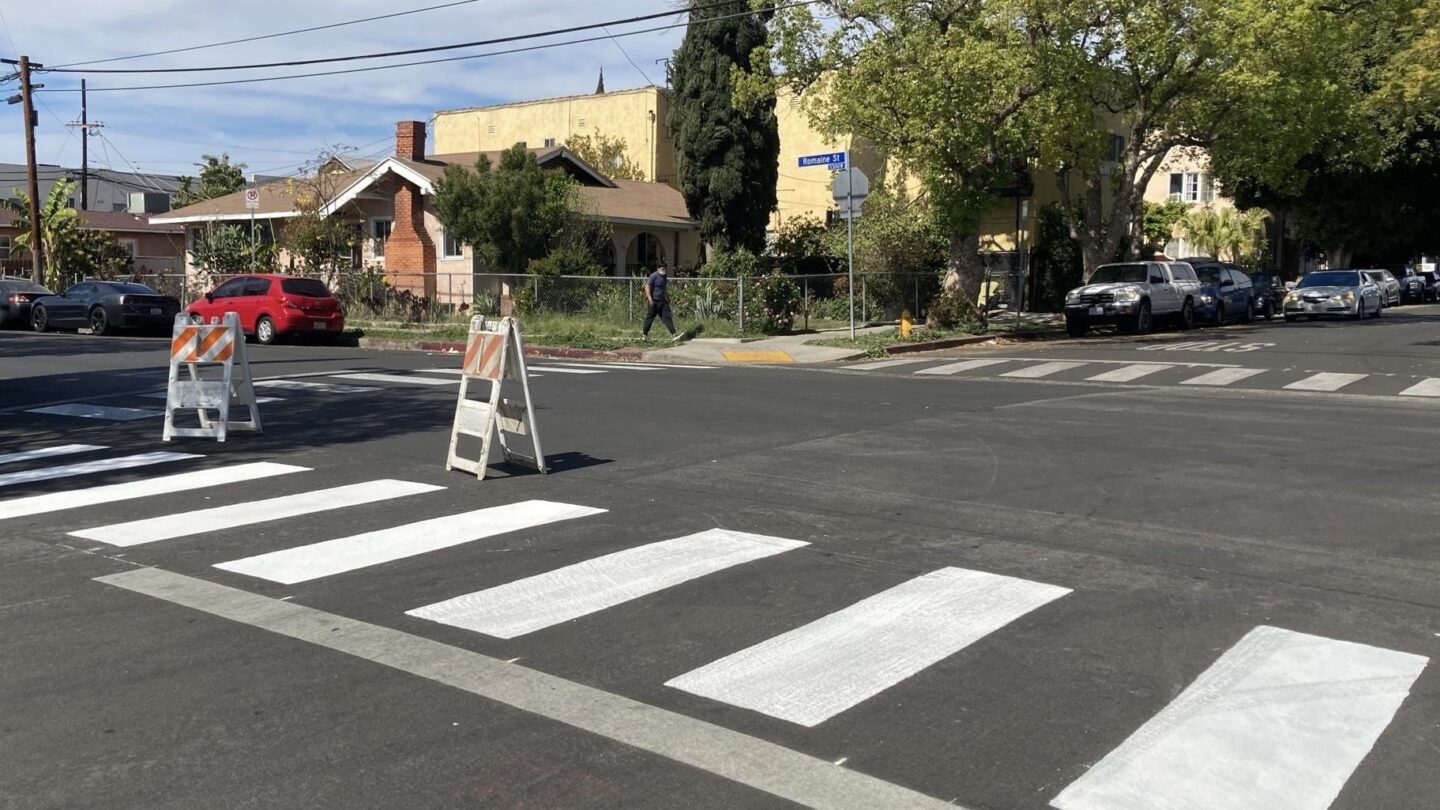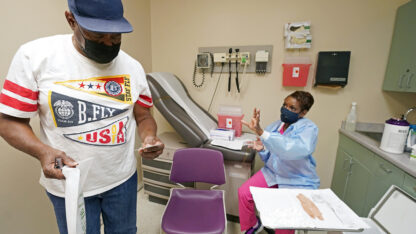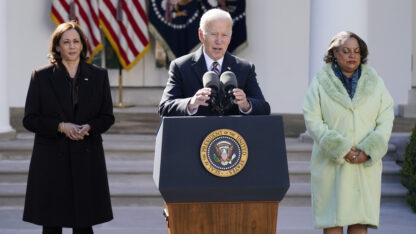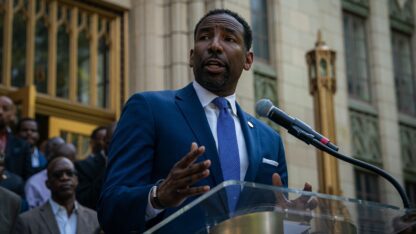A secretive LA group has a new mission: paint untouched crosswalks

There’s a mystery on the streets of Hollywood in Los Angeles.
A series of striped crosswalks suddenly appeared at a busy residential intersection, and the secretive group that claims it’s behind the do-it-yourself project says it has more in the works.
“The city doesn’t keep us safe, so we keep us safe,” Crosswalk Collective LA announced on Twitter in a post that included photos of the freshly painted intersection at a four-way stop at Romaine Street and Serrano Avenue.
So far, the group has revealed little about its membership or if there was a particular incident that preceded the safety installation, but it is clear they intend to continue to take matters into their own hands.
“We are a small group of community members who have tried for years to request crosswalks and other safe streets infrastructure the official way,” they told NPR in a statement.
“At every turn, we’ve been met with delays, excuses, and inaction from our city government, as well as active hostility to safe streets projects from sitting councilmembers,” the Collective added.
Streets for All, which studied data from the Los Angeles Police Department, says 128 pedestrians were killed in Los Angeles 2021, an increase of 6% over 2020. That means a person on the streets was killed every three days, which is “four times the national average.”
Another 486 people were severely injured, marking a 35% increase over the previous year. Polling by the organization, which advocates for pedestrian safety and alternative transportation in Los Angeles, found that just over half of Angelenos say that crossing the street in their neighborhood is dangerous.
Nationally, there has been an uptick in pedestrian deaths during the pandemic, according to the Governors Highway Safety Administration.
How the city has been responding
LA Department of Transportation spokesman Colin Sweeney said the public’s best bet to ensure safety measures are properly installed, is to go through the proper channels.
“We encourage individuals and organizations to work with us,” Sweeney told NPR, adding that residents should contact LADOT’s regional district offices or their local council members with concerns.
But even the head of the department has admitted that the machinery of the government can move like molasses. In an interview with LAist, LADOT General Manager Seleta Reynolds “pointed to a reliance on outside grants and a lack of city funding.” She also explained the department is hamstrung by reasons “that are somewhat political and somewhat about outreach.”
Meantime, Sweeney confirmed that the department has been made aware of the recent set of unapproved crosswalks, and said that “any unauthorized alteration to a street is subject to removal.” (Sweeney did not specify if or when the vigilante crosswalk may be eliminated.)
The city has a history of quickly buffing out painted street and sidewalk DIY modifications, whether they’re guerilla bike lanes or more artistic safety projects that highlight the city’s deteriorating infrastructure.
With regard to Crosswalk Collective LA’s allegations that “at every turn, we’ve been met with delays, excuses, and inaction from our city government,” Sweeney said there is no record of that with LADOT — at least not in reference to the specific intersection in Hollywood.
While it’s possible individual members may have contacted the office or other local officials, Sweeney said the only requests submitted for the corner of Romaine Street and Serrano Avenue date back to 2017. The request to convert the stop sign at the location from a two-way stop to a four-way stop, was completed in 2017. An additional request to fix a broken street sign the same year “was promptly completed,” Sweeney added.
The spokesman also said there are more safety plans for the street corner in the works.
Councilman Mitch O’Farrell’s office, which represents the area where the Collective installed the crosswalks, told NPR it hasn’t heard from the group either.
“Since taking office, our district has installed or upgraded more than 500 crosswalks, nearly 100 speed humps, and more than 250 stop signs,” spokesman Dan Halden told NPR in a statement.
When asked how long on average it takes for a community-led request for a stop sign or crosswalk to be implemented, Halden said the time frames vary — without providing more specific information.
The public is praising the activists’ initiative
It’s clear the group’s actions have struck a chord with residents.
In the week since Crosswalk Collective LA took to the streets in their bright neon vests, white hard hats and buckets of white paint, the public response on Twitter appears to be largely positive. The general consensus is that official, city-approved safety improvements take too long to come to fruition, if and when they happen at all.
“Omg! If you have the time I’ve been trying to get a crosswalk on 8th and Ridgeley !!!,” one person said on Twitter.
“Desperately need this at Ave 52/Monte Vista in Highland Park,” commented another user.
Yet another posted a photo of a letter they said was from LADOT. It said that after an engineering traffic study, the city would not be installing a crosswalk at the requested spot.
The group of rogue activists say they’re keeping a list of the intersections highlighted by followers — more than two dozen so far. To streamline the process, they have added an English and Spanish form to their Twitter account so that people can formally submit requests for crosswalks.
And the enthusiasm appears to be gaining momentum beyond Los Angeles.
“What is your process for installing a crosswalk? wanna copy it in Atlanta,” wrote someone on Twitter.
The Collective responded immediately: They will be sharing a how-to guide — replete with a “professional grade stencil” design, which means a DIY crosswalk could be coming to a street corner near you.
9(MDAxODM0MDY4MDEyMTY4NDA3MzI3YjkzMw004))








